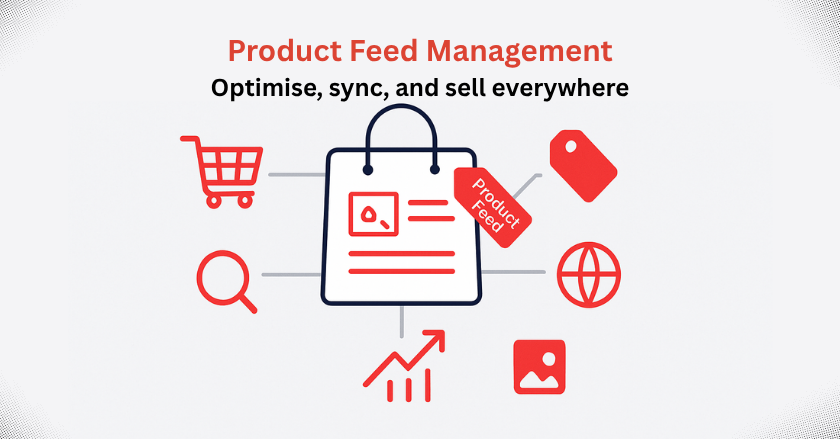
Getting your product seen by potential customers is everything an online seller wants. For that, your product feed must be clean, accurate, and optimised to showcase products on Facebook, Google Shopping, or other marketplaces. A product feed is a structured file that contains all the important information about the product, like title, price, description, image, and more. This data is used by platforms to display your products in search results and shopping ads.
When your product feed is outdated and contains errors, your ads may be disapproved and underperform, often resulting in low visibility and lost revenue. That’s why you need a proper feed management as it helps your listings meet platform requirements and keep the feed updated in real-time.
In this blog, we’ll discuss what product feed management is, why it matters, and which tools can make the process easier. You’ll also learn proven best practices to keep your feed healthy and effective.
What is product feed management?
Product feed or data feed management is the process by which you organize and refine your digital product catalog to improve marketing and promotion efforts across different channels. A product feed contains important details of the product, like title, price, image, stock status, brand, and more. Effective feed management simplifies e-commerce sales as it:
- Optimise performance and product visibility
- Refine the data source to target the desired audience
- Comply with the requirements of each channel
- Create relevant and updated product data
Why is feed management important?
Feed management is an important component for your e-commerce store’s success.
Increases visibility and reach
Your product visibility increases on marketplaces and other channels as it appears in the relevant searches with a well-organised feed. More potential customers search for the product, which ultimately drives traffic to your online store and increases the conversion rate.
Improved Ad performance
Quality product feeds enhance your ad performance. When your product details are clear, your ads become more relevant. That helps you get better placement on Google Shopping while lowering your costs.
Provide a better user experience.
Accurate and consistent products feed increases trust of customers as they have access to updated and reliable information about your product. If your product details are different on each channel, shoppers get confused, which reduces their trust, and they may not buy.
How Prodcut Feed Works?
An optimal product data feed contains the following components:
- Product name
- Price
- SKU
- Stock Availability
- Brand
- Images
- Product category
- Product URL
The process of product Feed Management involves the following steps:
1. Product data collection
Collect all the essential product details from your store. This includes the product title, images, availability, and more.
2. Format the data
Organize your product data for Shopify into a file format such as a CSV (comma-separated values) file to ensure compatibility across different channels.
3. Data Enhancements
Your product information must be appealing to customers. Use high-quality images and write seo optimised descriptions. Make effective use of optional fields like brand and SKU.
4. Check for errors
Review all the information about your product carefully, as everything must be accurate. Fix mistakes so your listings meet the rules of each platform.
5. Build the feed
Combine all the enhanced product data into one complete feed. This file will be used to publish your products on e-commerce platforms.
6. Optimize the feed
Use keywords smartly in titles and descriptions. Tailor the feed to match the needs of each channel. Follow the best practices to improve visibility.
7. Upload the feed
Submit your feed to each platform. Follow their submission rules closely to make sure your products show up correctly.
8. Track feed performance
Monitor how your feed performs. Note clicks, views, and conversion rate. This helps you spot issues or products that need improvement.
9. Keep the feed updated
Always keep your feed fresh. Update it regularly to reflect changes in inventory, pricing, or availability.
Top Tools for Product Feed Management
There are several tools and software that are developed specifically for product feed management that help businesses optimise product details and also simplify the process, and increase efficiency.
If you’re a Shopify store owner, check out our in-depth guide on the best feed management tools for Shopify to find the right solution for your needs.
Tools like Wixpa provide automated solutions to increase Shopify sales across multiple online marketplaces like Pinterest, TikTok, Google, Twitter, Facebook, and Microsoft. These tools support
- Multi-channel product feed distribution
- Real-time syncing and updates
- Error correction and feed approval
- Smart rule-based optimization for higher performance
1. Wixpa Google Shopping Feed
Wixpa is a user-friendly, all-in-one product feed management app designed to support growing e-commerce businesses.
Key Features:
- Supports multi-channel integration, including Google Shopping, TikTok, Facebook, Pinterest, Snapchat, and more.
- Keeps your product data synced in real-time to save time and reduce manual effort.
- Detects and fixes feed errors before submission, which improves feed approval rates.
- Allows custom rule settings for each channel to meet specific requirements.
- Fast and perfect for businesses of all sizes.
2. Simprosys Google Shopping Feed App
Simprosys is a Shopify app well-known for managing and submitting product feeds to Google.
Key Features:
- Designed especially for Shopify sellers using Google Shopping and YouTube.
- Offer with bulk product edits and real-time sync across platforms.
- Helps in setting up product categories and shipping settings easily.
- Simple interface and responsive support make it beginner-friendly.
- Best for merchants running paid ads on Google networks.
3. DataFeedWatch
DataFeedWatch is known for its flexibility and ability to customize feeds for over 2,000 channels.
Key Features:
- Create rules to edit product titles and categories by channel.
- Track your product feed performance using smart, built-in analytics.
- Quickly duplicate and tailor your feeds for different countries and regions.
- Clean interface suitable for both small and large businesses.
- Excellent for agencies managing multiple client accounts.
4. Feedonomics
Feedonomics is an enterprise-level platform for high-volume sellers with complex feed needs.
Key Features:
- Automates product feed tasks and keeps listings compliant on all channels.
- Works well with major marketplaces like Amazon, Walmart, and more.
- Offers expert onboarding and ongoing support from a dedicated team.
- A powerful option for large e-commerce brands managing high volumes.
5. Channable
Channable is a feed tool that combines data management with ad automation features.
Key Features:
- Create and manage product feeds for Google, Amazon, and other top channels in just a few steps.
- Set rules based on performance to fine-tune and improve how your products appear.
- Run and control your Google Ads campaigns right from the same platform.
- Use a clean and simple dashboard that makes multi-channel selling easy to handle.
- A smart choice for digital agencies and internal marketing teams looking to save time.
Best Practices for Shopify Product Feed Management
There are several tools by Shopify that businesses can use to customize product information, update feed descriptions, and conduct survey analytics for the best feed management system. To optimise product feed management, you can adopt the following proven best practices:

Use High-quality Images
The image is the first impression of your item on the user. So your product image must be clear and attention grabbing which builds trust and attracts more clicks. Do not use watermarked and blurry pictures.
Write SEO-optimized titles and descriptions
Well-written content significantly increases visibility and drives more qualified clicks. Use the keywords that are relevant and match user search intent. Avoid keyword stuffing. Write a creative and accurate title and description. Your product description must be so compelling that it converts a casual visitor into a potential customer.
Add all required and optional fields
Include all the important details of the product, like GTINs and brand names. Fill in required as well as recommended fields, as it gives you a better chance of approval and improves ranking on shopping platforms.
More complete data = better performance.
Keep Feed Data Fresh and Up-to-Date
Outdated price or stock info can lead to disapprovals or customer dissatisfaction. Sync your product feed regularly. You can also feed to reflect real-time changes in inventory, pricing, or availability. Consistency builds trust and reduces errors.
Use Rules to Customize Data for Each Channel
Each platform has its own formatting and content preferences. Create smart rules to adjust product titles or pricing per channel. For example, your Google Shopping title can differ slightly from your Meta title for better targeting.
Monitor Performance and Make Improvements
Use analytics to track which products are performing well and which aren’t getting clicks. Use this insight to tweak your feed and test different strategies for continuous improvement. Also, make effective use of dynamic remarketing to target previous visitor with customized ads based on their interaction with your Shopify store.
Final Take
A well-optimised product feed is important for your e-commerce success. Such feed ensures your listings are visible, optimised, and approved across all channels. Keep your feed updated, use quality images, and follow other such practices to optimise your feed.
Tools like Wixpa help you manage product data feed effectively. Such software saves time, ensures accuracy across channels, and provides error-free solutions.
FAQs
1. How do I create a product feed in Shopify?
You can create a product feed in Shopify using built-in automated tools to add product details according to varying platform requirements. Various automation tools like Wixpa can also help you make a product feed. These apps automatically pull your product data and format it for platforms like Google and Facebook.
- Install the app
- Connect your sales channels
- Customize your feed settings
These management tools will then sync your product listings in real time.
2. How often should I update my product feed?
You should update your product feed daily or in real-time so that your inventory, pricing, and availability stay accurate and updated across all platforms. Outdated feeds can lead to disapprovals and missed sales. Automated tools make frequent updates easier and more reliable.
3. Can I manage my feed without a tool?
Yes, you can manage your feed manually, but it’s not practical for growing businesses. Manual updates often take time and increase the risk of errors. Tools and applications streamline the process and reduce workload. Your product information also improves accuracy across all channels.
4. What causes product disapproval in Google Merchant Center?
Google may disapprove products due to
- Mismatched prices
- Incorrect availability
- Missing required data like GTINs or MPNs.
Other common issues include
- Low-quality images
- Policy violations
- Broken URLs.
Regular monitoring and clean feeds can prevent these problems.
5. What are the common Issues associated with Product Feeds?
Even one mistake in your product feed can lead to disapproval. Here are common issues
- Missing GTINs or MPNs
- The title is too short or too long
- Image issues
- Price mismatch
- Incorrect availability





